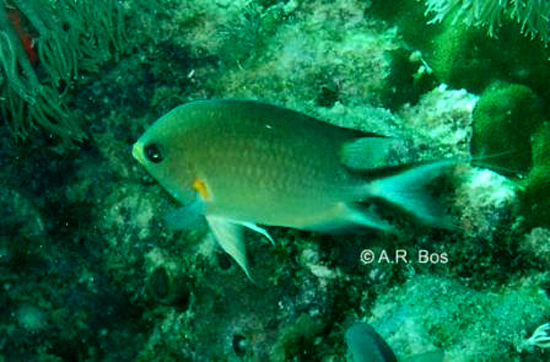| Pomacentridae (Damselfishes), subfamily: Chrominae |
| 10 cm TL (male/unsexed) |
|
reef-associated; marine; depth range 5 - 70 m, non-migratory |
| Western Pacific: Christmas Island and the northwest shelf of Australia in the eastern Indian Ocean to as far east as Samoa, Tonga (Ref. 53797), and the Marshall Islands. |
|
Dorsal spines (total): 12-12; Dorsal soft rays (total): 12-13; Anal spines: 2-2; Anal soft rays: 12-13. Description: Body greyish brown; pectoral fin axil yellow-orange; dorsal, anal and caudal fins margin dark brown (Ref. 90102). Caudal-fin lobes tips end in two filaments. Juveniles have more blue around the eyes and the margins of the dorsal and anal fins, as well as elongate outermost caudal rays (Ref. 1602). Body depth 1.5-1.7 in SL (Ref. 90102). |
| Adults inhabit coral-rich areas of clear lagoon and seaward reefs. Abundant on steep outer reef slopes below 24 m, uncommon in lagoons. Juveniles in large branching corals, adults mainly in caves (Ref. 48636). Found in aggregations (Ref. 9710). Diurnal species (Ref. 54980; 113699). Oviparous, distinct pairing during breeding (Ref. 205). Eggs are demersal and adhere to the substrate (Ref. 205). Males guard and aerate the eggs (Ref. 205). |
|
Least Concern (LC); Date assessed: 16 November 2010 Ref. (130435)
|
| harmless |
Source and more info: www.fishbase.org. For personal, classroom, and other internal use only. Not for publication.
